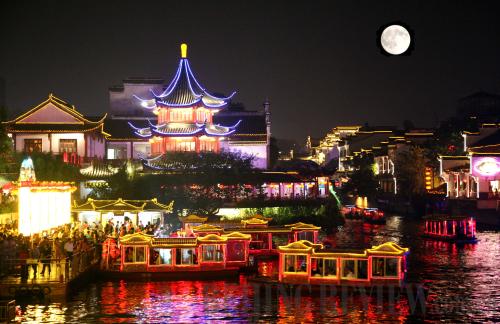|
 |
|
PICTURESQUE EVENING: A bright Moon shines above the illuminated Confucius Temple in Nanjing, Jiangsu Province, during the Mid-Autumn Festival of 2009 (CFP) |
September 22 will be the Mid-Autumn Festival, a traditional Chinese festival celebrated on the 15th day of the eighth month each year according to the lunar calendar.
It usually falls in late September or early October, the middle of autumn.
Origin
The Mid-Autumn Festival has a long history. Generally speaking, there are three explanations about its origin. The first says it stemmed from ancient emperors' worship of the Moon. The second says it evolved from the folk custom that young girls and boys often dated, usually singing and dancing, under the full Moon. The third says it came from the tradition to sacrifice the God of Earth for the autumn harvest.
In ancient China, royal families observed a ritual of offering autumnal sacrifices to the Moon. Later, aristocrats and literati followed the ritual, and the practice gradually spread to the common people.
By the Tang Dynasty (618-907), people attached greater importance to the moon appreciation and worship, and the custom gradually developed to be a fixed festival. Celebrations became even grander in the Song Dynasty (960-1279). In the Ming and Qing dynasties (1368-1911), the festival grew to be one of the most important festivals in China.
On that day, the Moon looks extremely round, big and bright. Family members and friends usually get together, put food on tables in the open air and appreciate the full Moon. They also express their yearning for a reunion with those family members or friends who are unable to be present for the get-together. This is why the festival is also called the Festival of Reunion. It is also a good time for matchmaking.
Moon cakes, a kind of sweet pastries, usually round, are the indispensable food eaten during the festival, so the festival is also called Moon Cake Festival.
 |
|
LEGENDARY: Chang'e, a mythological figure played by an actress, flies to the "Moon," a big balloon, at a celebration for the Mid-Autumn Festival in Shanghai (CFP) | For Chinese, the Mid-Autumn Festival is also a poetic time. Many Chinese poems and essays are about the Moon. For example, Su Shi (1037-1101), one of China's greatest poets and calligraphers, has left a good number of poetic lines about the Moon. The most famous ones include:
People have sorrow and joy, they part or meet again;
The Moon may be bright or dim, she may wax or wane.
There has been nothing perfect since the olden days,
So let us wish that men
Will live long as they can!
Though miles apart, we'll share the beauty she displays.
In China, there are many legendary stories about the festival and they are part of many people's memories of their childhoods. On that day, children may eat moon cakes under grape trellises in the bright moonlight, and listen to moon stories told by their mothers or grandmothers. The stories are mostly about Chang'e, a beauty who was said to fly to the Moon, the Jade Rabbit, which was believed to live on the Moon, and Wu Gang, a young man who was said to chop the laurel tree on the Moon.
Celebrations
China is a country of vast area, large population and multiple ethnic groups. People in different parts of the country follow various customs, but they all enjoy the full Moon and eat moon cakes at the Mid-Autumn Festival.
The Moon was deified by ancient Chinese people. At that time, only royal families had the right to hold sacrificial ceremonies to the Sun and the Moon, a way for them to communicate with the Gods of Sun and Moon.
Ordinary families were only allowed to hold moon worship. People put statues of gods and tributes on altar tables. In addition to moon cakes, usually pears, apples, grapes, green soy beans, and watermelons were offered as tributes by people in the north, while grapefruits, taros, bananas, peanuts and lotus roots were offered in the south.
Sometimes, no altar was used. In these cases, people knelt down toward the Moon after it rose on the day. Incense was burned and fire crackers were let off. When the incense was lit, women would worship first, followed by the children.
An old saying in China goes, "a man does not worship the God of Moon, while a woman does not worship the God of Kitchen." In this sense, the Mid-Autumn Festival is a women's festival, and a time for women to pay respects to the God of Moon.
|
